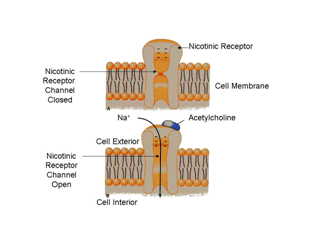Part 4: The Cholinergic Toxidrome
Section 2: Nicotinic Acetylcholine Receptors
- Learning Objectives
- Key Function of Nicotinic Receptors
- Molecular Physiology of Nicotinic Receptors (Chemical-Gated Na+ Channels) (Optional Reading)
- Molecular Structure and Physiology of the Nicotinic Receptor (Optional Reading)
- Locations of Nicotinic Receptors
- Clinical Findings Due to Nicotinic Stimulation from Cholinesterase Inhibitors
- Nicotinic Mnemonic
- Key Points
- Progress Check
The key function of nicotinic receptor proteins is to trigger rapid neural and neuromuscular transmissions.
For those interested in learning about the molecular physiology of nicotinic receptors, the subject is discussed as optional reading below.
Physiology of nicotinic receptors
The nicotinic receptors are cylindrically-shaped proteins imbedded in synaptic walls that act as chemically-controlled sodium channels (also called ligand-gated sodium channels) that penetrate through the cell walls of post-synaptic nerves and myocytes at the skeletal neuromuscular junctions. (Guyton and Hall 2006) (See Figure 6 below) (Smooth muscle contraction is controlled by muscarinic receptors, which are different and will be discussed later.)
When the neurotransmitter, acetylcholine, attaches to the portion of the nicotinic receptor outside of the cell wall, it induces a conformational change that selectively opens up the channel to sodium ions. The resulting influx of positively charged sodium then triggers membrane depolarization. Depolarization is followed by the opening of other transmembrane channels that selectively allow the flow of K+ ions into the cell. This results in repolarization. The period between depolarization and repolarization is called the refractory period. This is because during this time the cell cannot be depolarized by an additional stimulus. (Guyton and Hall 2006)
The channel opening in the nicotinic receptor normally lasts less than a millisecond because the enzyme, cholinesterase, rapidly breaks down acetylcholine. Since channel opening is triggered by the attachment of a chemical (or “ligand”) — in this case, acetylcholine — these channels are called chemical- or ligand-gated channels. As long as the chemical (in this case acetylcholine) is attached, the channel stays open. (Guyton and Hall 2006)
Toxic levels of cholinesterase inhibitors prevent the breakdown of acetylcholine. As a result, the chemical-gated nicotinic receptor Na+ channels are held in the open position, and a constant state of depolarization occurs. This results in a prolonged refractory period, during which no further transmission can occur. This is referred to as a depolarization block, and is similar to the depolarization block caused by succinylcholine. (Taylor 2001)
Clinical Picture Due to Nicotinic Effects of Cholinesterase Inhibitors
These events help to explain why the initial phase of toxicity is manifested by over-stimulation (characterized by myoclonic jerks, fasciculations and muscle spasms) followed by weakness progressing to paralysis.
Nicotinic receptors are located in the (See also Figure 6)
- Skeletal neuromuscular junctions.
- Sympathetic and parasympathetic nervous system.
- Autonomic ganglia.
- Central nervous system.
Clinical findings are related to effects on the:
- Neuromuscular junctions of skeletal muscles.
- Fasciculations and myotonic jerks, followed by weakness and paralysis.
- Sympathetic nervous system (due to ganglionic stimulation of the adrenal gland). (See Figure 5)
- Hyperglycemia, glycosuria, ketosis. (Schenker, Louie et al. 1998; Clark 2002)
- Hypertension. (Erdman 2004)
- Leukocytosis with a left shift. (Schenker, Louie et al. 1998; Tareg, B et al. 2001)
- Mydriasis (pupillary dilation) (Erdman 2004) (in up to 13% of the cases (Clark 2002)).
- Sweating.
- Tachycardia, tachydysrhythmias. (Erdman 2004)
- Urinary retention. (Clark 2002)
The table below shows a mnemonic for remembering the nicotinic signs of cholinesterase inhibitor toxicity
Monday
Monday
Mydriasis (pupillary dilation)
Mydriasis (pupillary dilation)
Tuesday
Tuesday
Tachycardia
Tachycardia
Wednesday
Wednesday
Weakness
Weakness
Thursday
Thursday
Hypertension
Hypertension
Friday
Friday
Fasciculations
Fasciculations
- A key function of nicotinic receptors is to trigger rapid neural and neuromuscular transmission.
- Nicotinic receptors are found in:
- The somatic nervous system (neuromuscular junctions in skeletal muscles).
- The sympathetic and parasympathetic nervous system (autonomic ganglia).
- The central nervous system (Discussed later).
- Peripheral nervous system clinical findings include
- Fasciculations and myotonic jerks (central nervous system effects are discussed later).
- Weakness and paralysis.
- Sweating.
- Mydriasis (pupillary dilation) (in up to 13% of the cases).
- Tachycardia, tachydysrhythmias.
- Hypertension.
- Hyperglycemia, glycosuria, ketosis.
- Leukocytosis with a left shift.
